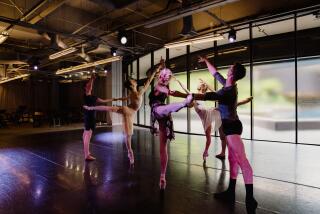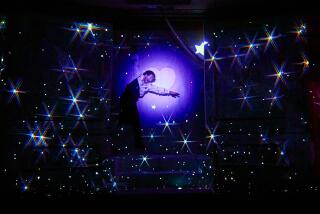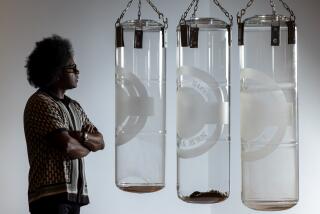Gideon Obarzanek choreographs a new role for himself
- Share via
Gideon Obarzanek can trace much of his artistic drive to a creative restlessness that stems, he says, “from an interest beyond pure dance.”
“How can dance coordinate with other forms?” he asks. “This has been a creative engine for me, in that I’ve been able to make unique works. But it’s also a frustration. Because a part of me always wants to go off and do other things and then I keep getting pulled back into a dance context.”
Since founding the Australian dance company Chunky Move in 1995, Obarzanek has consistently pushed the boundaries of how contemporary dance can be viewed and understood through mining his omnivorous interests in theater, film, visual art, science and technology. In the process, he transformed Chunky Move into one of Australia’s leading dance companies with an international following and a strikingly diverse and edgy oeuvre that includes site-specific works, highly theatrical narrative-driven dance and more abstract, imagistic productions where he filters his choreography through various technological prisms. His 2006 “Glow” and 2008 “Mortal Engine,” for example, made use of interactive motion-tracking software that generated hallucinatory video graphics from the dancers’ movements.
“Working with Gideon is never boring,” says Stephanie Lake, who has danced in Chunky Move productions for the last decade. “His approach from one piece to the next is always so different and he’s always bringing in a different set of collaborators. You never know what you’re going to get with him, except that he always comes up with these big ideas that are visually compelling from the outset.”
Currently in the process of transferring the reins of his company to Dutch choreographer Anouk van Dijk, who will take over as artistic director by this summer, Obarzanek has spent the last couple of years engaged in several last-hurrah projects. This includes “Connected,” which will receive its Los Angeles premiere Saturday at the Luckman Fine Arts Complex. In the piece, five dancers will forge a highly physical, symbiotic relationship with a large kinetic sculpture by Bay Area artist Reuben Margolin. Consisting of a suspended matrix composed of paper, a loom-like contraption from which dancers can attach themselves with strings and multiple pulleys and magnets, the sculpture was designed “to be incredibly responsive to movement,” Obarzanek says. “The sculpture became like an instrument that the dancers could play.”
Speaking by phone from his company’s Melbourne-based office, the cordial and articulate 45-year-old choreographer describes encountering Margolin as a kindred spirit at the 2009 PopTech conference, an annual networking event in Maine targeted toward innovative thinkers from a variety of disciplines. Both men had watched each other’s presentations, hit it off later at a bar, discovered a shared love of mathematics and talked of possibly collaborating.
“What impressed me about Reuben was that his sculptures seemed to transcend their concrete form,” Obarzanek says. “Once they were set in motion, there was this sense of flow, and this kind of transformation really reminded me of how dancers can transcend their individual personalities and become just these figures in space.”
Obarzanek wound up visiting Margolin at his studio in Emeryville, Calif. “And right away, I got out some string and we started playing around,” recalls Margolin, who said he felt “excited by the opportunity to break away from the mechanics of my work and have the input of the human body.”
“Plus, I found Gideon’s work to be both visually stunning and rich with meaning,” he added.
Wanting more than just “a virtuosic spectacle of what these dancers can do” with Margolin’s sculpture, Obarzanek created a narrative where the dancers bring the sculpture to life by partially constructing it onstage. “We had to figure out a system for the dancers to do this quickly, and at first this was a nightmare,” he recalls. “We also had to figure out where to attach the strings of the sculpture to the parts of the body that could move the sculpture in the most dynamic of ways.”
Obarzanek seems to have thrived on challenge from an early age. Born in Australia, he lived on a kibbutz in Israel until age 8. Returning to Melbourne with English as a second language, he says, “was a sink or swim situation.”
“There were no remedial English classes and I was just thrown into school,” he adds. “Fortunately, I chose to swim, but my confidence in English took a long time and I found myself excelling in math and visual art.”
After discovering a passion for dancing from experimenting in clubs during high school, Obarzanek took his mother’s suggestion to try formal training. He wound up getting accepted into the Australian Ballet School and deferred his plans to study marine science at a university. Initially, he found it “very hard to relate” his ballet studies to his passion for social dancing and organic movement. But one day, Nederlands Dans Theater came to visit his school. Watching that company, he recalls, “I saw how ballet could be transformed and how it could connect to the dancing that I had loved to do in clubs.”
Obarzanek worked as a professional dancer for about five years, performing with the Queensland Ballet and the Sydney Dance Company before striking out on his own as an independent choreographer. Some two decades later, he welcomes the opportunity to return to the life of a freelance artist.
“I’m in a very good place,” he says, noting how a chance meeting with Australian actress Cate Blanchett landed him a gig as an associate artist with the Sydney Theatre Company. “After 16 years of running my own company, I want to put my energy into the works themselves and not so much into an organization. I’m lucky that I’m in a position now where I can walk away from Chunky Move knowing it will do well without me.”
More to Read
The biggest entertainment stories
Get our big stories about Hollywood, film, television, music, arts, culture and more right in your inbox as soon as they publish.
You may occasionally receive promotional content from the Los Angeles Times.










